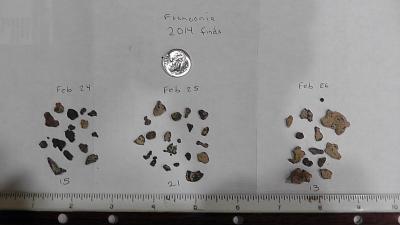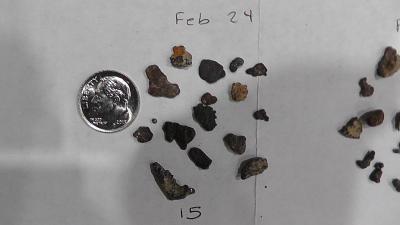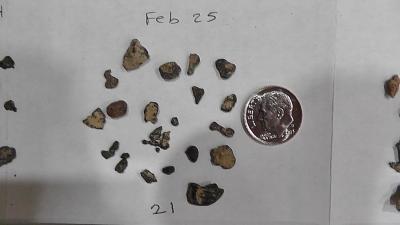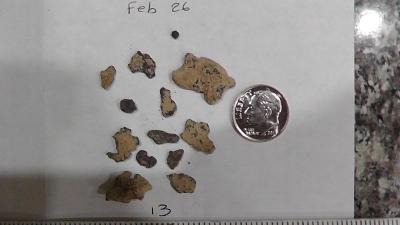
Paleomanjim
Full Member-
Posts
6 -
Joined
-
Last visited
Paleomanjim's Achievements

Contributor (2/6)
2
Reputation
-
Finding Small Iron Meteorites With Gold Bug 2
Paleomanjim replied to Paleomanjim's topic in Metal Detecting For Meteorites
A cold find is any new meteorite found that is not associated with a known strewn field or known fall.....I think -
Finding Small Iron Meteorites With Gold Bug 2
Paleomanjim replied to Paleomanjim's topic in Metal Detecting For Meteorites
I'll second that.... "Rocks from Space" by Richard Norton is the best place to begin to learn about meteorites. It inspired me to start searching, but I am lucky because we have several meteorite strewn fields out here in the south west. Strewn fields were created by much larger falls, like the one last year in Russia that produced thousands of small meteorites. Though rare, there must me many strewn fields, including Alaska, waiting to be discovered. It took me 3 trips of several days each to find my first meteorite several years ago. The first problem (if using a metal detector) is learning the distinctive sound a meteorite gives compared to a hot rock. I am sure I passed my detector over many meteorites thinking it was another hot rock before I finally learned that distinctive sound. What helped for me was to purchase several chondrite meteorites on Ebay and study them often. Some NWA (North West Africa) meteorites can be purchased for less than $20 and are great study pieces. Purchase only from dealers though and avoid Chinese meteorites (many are fakes). I bought a 45 gram NWA "H" type chondrite for $15 early on and used it as a throw down for my detector to zero in on the correct sound. That helped a lot. It had nice fusion crust, another feature you want on a study piece. I also picked up some 5 grammers and ground windows on them to be able to see what the inside of a chondrite should look like (visible metal flakes and possible chondrules). Without the study pieces it is very hard for a beginner to be able to tell the difference between an ordinary rock and a meteorite, as many ordinary rocks will stick to a magnet and some (like magnetite) can even appear to have fusion crust. Learn how to do a streak test, red, grey or black streaks are usually meteor wrongs. I have never found a "cold find" although I have made several trips to search for one. I have tried both searching with a metal detector as well as just a magnet stick. It takes an incredible amount of patience to swing a detector for hours on end in the open desert knowing that the odds of a find are extremely thin. And yet it is also probably likely that every square mile of desert (and any land for that matter) has several meteorites on or close to the surface! I usually use a magnet cane for cold find searching now and try to use my eyes for the right "look". A lot more ground can be covered and for me it is just more enjoyable. I am guessing most cold finds were found with a magnet stick, not sure though. Hunting in Alaska would be pretty tough, especially near Anchorage and the population centers because of the forests. That would probably require a detector to search. The tundra areas would probably be best, many Mammoth tusks have been found in the Tundra in Alaska and especially Siberia. Ice fields and glaciers produce thousands of visible meteorites but mostly from Antarctica which has unique processes. Each year teams of searchers from many countries search Antarctica. Meteorites from falls thousands of years ago are found there in good numbers as they are carried down hill by the "conveyor belt" of ice toward the sea. In specific areas the ice must move around or over the land beneath, which exposes it to the wind, eroding the ice and leaving the meteorite on the surface. Maybe similar conditions exist in Alaska....I dont know. Hope you give it a try. Every "cold" find" that is classified is a benefit to science and the understanding of how planets came to be, as well as us for that matter!.......jim -
Finding Small Iron Meteorites With Gold Bug 2
Paleomanjim replied to Paleomanjim's topic in Metal Detecting For Meteorites
Here are pics of the last finds. Irons at Franconia are small and are believed to have been part of the larger stony parent body. Because of their greater density they probably broke free during the atmospheric phase and separated. Looking at them with a 10X loop shows all kinds of cool features, melted nose cones, rollover lips, etc. ....I am headed to Gold Basin this morning and will return Wednesday...later....jim -
Thanks again Steve, you are definitely speeding up my learning curve. I live in Nevada now so it will probably be a few weeks before I can get back to the beach (my wife travels to California often and has a free companion pass so I tag along for free). I will share anything new I learn. Most of my experience has been with the Fisher GB2 on meteorites and while not related to beach hunting I have learned a few tips recently that have paid off. I usually hunt the Franconia Strewn field which consists of chondrites and tiny irons. Most of the chondrites have been found and most folks think the irons have as well. But many of the irons are tiny, some smaller than 0.1 gram. The irons exist in an area that has been more or less entirely gridded. I recently bought a 14" coil for my GB2 to allow me to cover more area and went back to Franconia a few weeks ago. I hunted the usual area of "iron alley". I kept the sensitivity maxed out at 10, as well as the audio and the audio boost switch on. I ground balanced often, but with these settings the GB2 more or less is continuously noisy. Anything less than max sensitivity would be a waste of time because most hunters run maxed out. Anyway, with all the visible scrapes and dig holes on the smooth desert pavement areas I decided to instead concentrate mostly on the areas with large basalt rocks from golf ball size to around softball size. The GB2 was screaming from all the hot rocks but every now and then I could hear a slight faint blip in the background. Sure enough many of these blips turned out to be irons and many were larger than normal up to 1.5 grams or so. After 3 days of hunting I had 49 irons and 2 chondrites, a new record for me! What I learned from all of this is to focus on the specific target sound or blip that usually indicates an iron and ignore all the hot rock sounds. It can be tough to do because the basalt hot rocks create a loud background chatter that is almost continuous. And most folks avoid the basalt area for that reason. This technique probably won't be much good with the ATX because it runs so quiet, but just thought I would share it. ....jim
-
Garrett ATX Review - Beach Detecting In Hawaii
Paleomanjim replied to Steve Herschbach's topic in Garrett Metal Detectors
Thanks Steve, great info to consider. I am comfortable in the water, lots of snorkel experience, but I'll try some shallow water hunting first, without weight belts. I know of one Laguna beach area that is usually protected from waves from offshore rocks and kelp beds and many swimmers snorkel there (including me) to check out the Garibaldi and other cool fish. I hunted the short section of beach there and found a lot of coins so maybe it has not been hunted much. The sand is only a few inches deep, underlayed by marble sized gravel. On the ATX settings I did notice a big change as soon as I transitioned from dry sand to wet sand. On the wet sand the ATX made a slight whine noise at the end of each swing. Next time I will try increasing the discrimination just a bit and perhaps I can then increase the sensitivity. It is fine either way, but I would prefer to run the machine as quiet as possible. I can always throw down a ring and listen to how it sounds against the background. The coins have been a great experience to learn the machine, but I am really only interested in the rings or jewelry. Again, thanks for the great tips and links, Jim- 22 replies
-
- jewelry detecting
- garrett atx
-
(and 1 more)
Tagged with:
-
Garrett ATX Review - Beach Detecting In Hawaii
Paleomanjim replied to Steve Herschbach's topic in Garrett Metal Detectors
Steve, thanks very much for sharing your experience with the ATX in Hawaii. Yours is the best info I have read about the ATX so far. I have had my ATX a few months now (my first PI machine) and I have been using it for meteorites, gold prospecting and twice at the beach. I like it a lot and use it in combination with by Fisher gold bug 2, depending on what I am searching for. So far I have been using the ATX with the discrimination always set at 0, the sensitivity usually at max, and fully ground balanced. On my 2 beach trips I had to reduce sensitivity to 9 or 10 which worked fairly well and I never really considered increasing discrimination. After reading your article I will experiment more with using discrimination and sensitivity together to optimize my target search. And also I will pay more attention to the high low or low high sounds to learn more about what the target actually may be. I have never tried underwater detecting but after reading this article you have got me fired up and ready to give it a go. I will need to buy the Garrett underwater phones and maybe a weight belt and perhaps a wet suit? I have done lots of snorkeling so I am ready to go there. Just curious about the weight belt though, is it really necessary? My concern is that the belt could be a safety issue in the surf? Or maybe there is a quick release....I have never used one. Also, how deep can targets be fanned underwater and do you fan in combination with a sand scoop? Sorry for all the questions, if there is a good book on underwater metal detecting you can recommend I would appreciate it. Thanks again for the great info, Jim- 22 replies
-
- jewelry detecting
- garrett atx
-
(and 1 more)
Tagged with:





